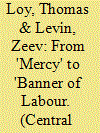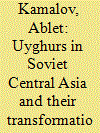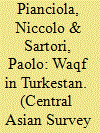| Srl | Item |
| 1 |
ID:
184421


|
|
|
|
|
| Summary/Abstract |
This paper presents the development and transformations of Bukharan Jewish newspapers and periodicals (1910–38) and situates them in the broader Central Asian mediascape. Over a period of 30 years, the Bukharan Jewish press was transformed from a pioneering privately owned enterprise that served the needs of the Jewish communities throughout Central Asia to one owned and regulated by the Soviet state, serving as a tool to transmit propaganda and to shape and educate a predefined ‘national minority group’. The paper argues that the introduction of a Bukharan Jewish press in 1910 was intended to create a modernized language and ethnic awareness among the Jews of Central Asia. In the 1930s, Bukharan Jewish newspapers and journals were radically Sovietized and finally shut down by the state. From then until the collapse of the Soviet Union, no Bukharan Jewish publications appeared in the bloc and the existence of a distinct Central Asian Jewish identity was largely ignored. This case study sheds light on Tsarist and Soviet minorities’ policies and helps us to better understand the various changes experienced and the cultural adaptations made by many ‘minorities’ of Central Asia in the Age of Colonialism.
|
|
|
|
|
|
|
|
|
|
|
|
|
|
|
|
| 2 |
ID:
028128


|
|
|
|
|
| Publication |
London, Chatto and Windus, 1972.
|
| Description |
viii, 246p. ill.Hbk
|
| Standard Number |
0701118415
|
|
|
|
|
|
|
|
|
|
|
|
Copies: C:1/I:0,R:0,Q:0
Circulation
| Accession# | Call# | Current Location | Status | Policy | Location |
| 010615 | 915/MYR 010615 | Main | On Shelf | General | |
|
|
|
|
| 3 |
ID:
185876


|
|
|
|
|
| Summary/Abstract |
Despite being in operation for a mere five years, the Soviet-era Tajik (Persian) journal Rahbar-i Dānish (1927–1932) was a key venue for exploring and debating the merits of Tajik literature in the context of new ideological and literary trends. Established litterateurs as well as literary newcomers published examples of their literature and literary criticism in this first Tajik monthly social, educational, and literary journal. The present article reviews the history of Rahbar-i Dānish and some of its authors to trace their influence on Tajik literature and literary criticism in the late 1920s and early 1930s. The article addresses the difficulties of creating a Soviet Tajik literature and scrutinizes the various genres featured in the literary section of the journal. Finally, it presents the trajectories of two literary newcomers, Jalāl al-Dīn Ikrām (who later became known as Jalol Ikromi) and Baḥr al-Dīn ʿAzīzī (who died in a Soviet prison in 1944), whose short stories were most prominent in Rahbar-i Dānish. This article is based on an almost complete set of the forty-five issues of the journal, published between August 1927 and March 1932.
|
|
|
|
|
|
|
|
|
|
|
|
|
|
|
|
| 4 |
ID:
075408


|
|
|
| 5 |
ID:
181817


|
|
|
|
|
| Summary/Abstract |
The article reviews major frameworks for re-evaluating Soviet Central Asian history in anglophone scholarship after the collapse of the Soviet Union. It tackles recent popular concepts such as ‘modernity’, ‘development’ and ‘modernization’ for analysing the Soviet past in the region. It questions the analytical value of the terms as well as their ability to capture the complexity of social, political and economic changes that Central Asia underwent in the course of seven decades between the October Revolution and the dissolution of the USSR. The article furthermore provides an overview of novel themes and approaches in the field and suggests themes for further research.
|
|
|
|
|
|
|
|
|
|
|
|
|
|
|
|
| 6 |
ID:
191078


|
|
|
|
|
| Summary/Abstract |
This article argues that the Kazakh–Kyrgyz relationship in many ways shaped the emergence of Soviet Kyrgyzstan. Kyrgyz elites were willing to collaborate with Kazakhs while simultaneously trying not to be marginalized by them. Kazakh elites in the Turkestan ASSR’s government supported the first Kyrgyz nationalist project, the Kara-Kyrgyz Mountain Oblast (KKMO), in 1922. However, the division of Turkestan during the Central Asian national–territorial delimitation in 1924 and the increased linkage between national identity and political and cultural rights deprived the Kazakh–Kyrgyz regions of their socio-economic unity. Consequently, Kyrgyz leaders, to get their fair share of the disintegrating Central Asian economy as a separate group, had to contrast themselves to their Kazakh allies. The case of Soviet Kyrgyzstan shows that the intertwined relationship among Central Asian elites provides a more nuanced and complicated story of the formation of Soviet national republics in the region. Particularly, Central Asia’s settled/nomadic dichotomy and the inter-elite relationship within each population have been more influential than scholars have acknowledged.
|
|
|
|
|
|
|
|
|
|
|
|
|
|
|
|
| 7 |
ID:
178907


|
|
|
| 8 |
ID:
082360


|
|
|
|
|
| Publication |
2007.
|
| Summary/Abstract |
The paper investigates early Soviet policies regarding the institution of waqf (charitable endowment) in Turkestan, questioning the issue of the post-colonial character of the early Soviet administration. After taking into consideration practices related to waqf management in modern Muslim states and European colonial empires, the paper briefly describes the tsarist administrative approach to the issue. We then address the ambiguity inherent in Soviet policies on waqf requisition and restitution during Civil War years. In the section that follows we deal with different groups of Muslim intellectuals that attempted to use the Soviet state in their mutual struggle over authority in Central Asian society and describe the creation and functioning of the bureaucracies responsible for managing waqf. Finally, we outline some provisional conclusions on the legacy of tsarist colonialism for Soviet power in Central Asia and the role played by progressive Muslim intellectuals
|
|
|
|
|
|
|
|
|
|
|
|
|
|
|
|